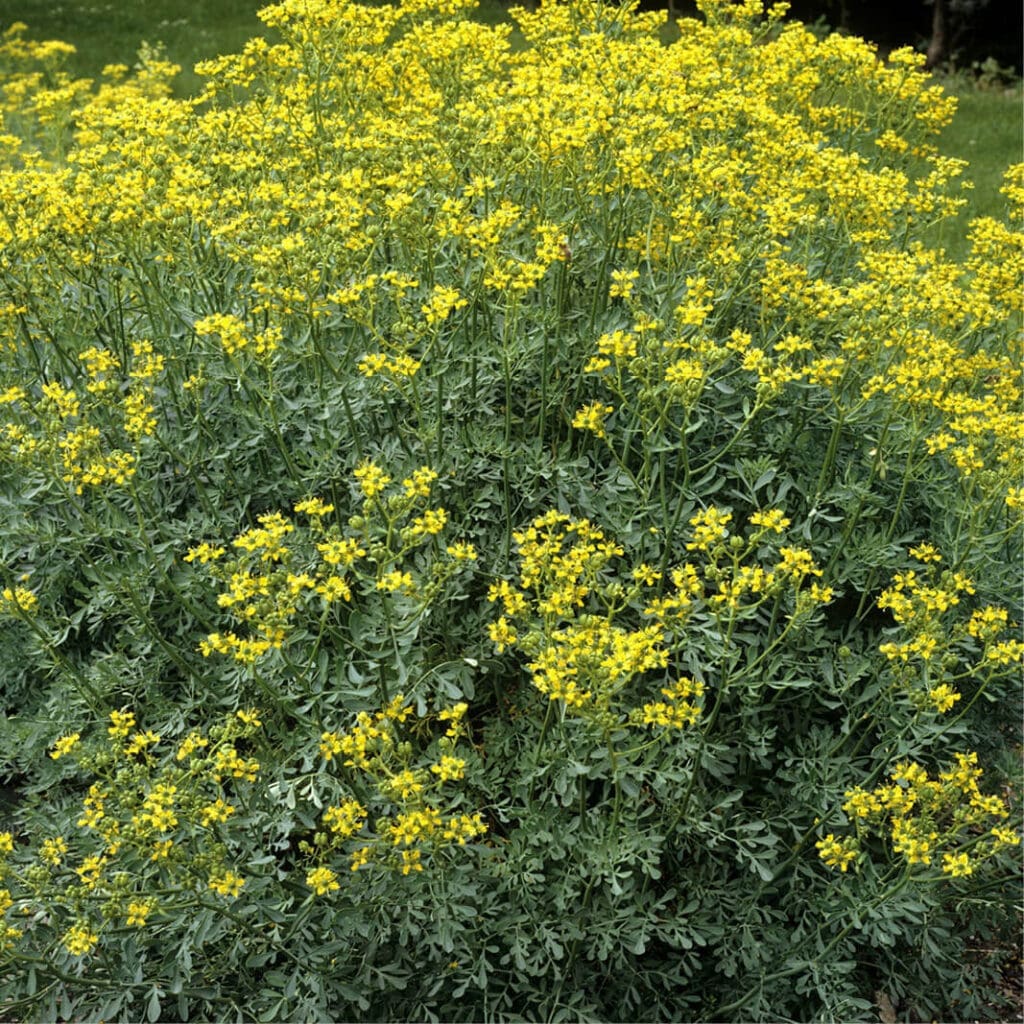
Ruta graveolens
Latin name: Ruta graveolens
Short name: Ruta
Common name: Rue | Herb-of-grace | Common Rue | Garden Rue | Bitter Rue
Primary miasm: Sycotic Secondary miasm(s): Psoric
Kingdom: Plants
Family: Rutaceae
- Symptomatology
- Remedy Information
- Differentiation & Application
Prepared from the fresh herb Ruta graveolens, a shrubby, strongly aromatic perennial native to southern Europe. The plant contains rutin, a flavonoid, and volatile oils that can cause skin irritation in sensitive individuals.
Historically used as a herbal remedy for eye strain, menstrual disorders, muscle pain, and as an abortifacient. Employed in ancient medicine for protection against poison and evil spirits. In modern phytotherapy, used with caution for muscular aches and as a digestive bitter.
Proved by Hahnemann, published in Materia Medica Pura and Chronic Diseases, with later confirmations by Boenninghausen and Hering
- Fibrous tissue and periosteum: tendons, ligaments, cartilage
- Joints: overuse injuries, especially wrists, knees
- Eyes: ciliary muscle fatigue, vision strain
- Lower back and sacrum: pain from lifting, sitting, or injury
- Rectum and anus: haemorrhoids, prolapse from straining
- Pelvic organs: uterine prolapse, weakness
- Connective tissue: general tone loss, bruising tendency
- Lying on back, or on painful part [Clarke]
- Pressure, especially on bruised or strained areas
- Motion, especially slow movement after rest
- Heat, warm applications or climate
- Stretching limbs, or changing position
- After rest (initial improvement)
- Cold, damp weather, especially from exposure after exertion
- Overuse, repetitive strain, prolonged physical activity
- Lying on sides, or lying long in one position
- Rest after exertion
- Sitting, especially on hard surfaces or for long periods
- Straining, particularly of eyes or rectum
- Rhus toxicodendron – Also for rheumatic, sprain-like pains, but Rhus-t. is restless and improves with continued motion; Ruta has more bruised, sore, lameness, worse after overuse.
- Arnica – For trauma, soreness, and bruising; Arn. is suited to shock and soft tissue trauma, Ruta more for deep tendon and periosteal pain.
- Bryonia – Similar stitching pains and dryness; Bry. is worse from motion, Ruta better after moving but worse from overuse.
- Calcarea fluorica – For ligamentous laxity, ganglia, and chronic joint issues; more suited to chronic degenerative conditions, Ruta more acute.
- Hypericum – Neuralgia after trauma, especially of fingers and spine; more focused on nerve pain, Ruta more for connective tissue.
- Complementary: Rhus-t., Calc-f., Arn.
- Antidotes: Camph., Bell., Sulph.
- Inimical: None clearly stated
- Follows well: Arn., Bry., Rhus-t.
- Precedes well: Sil., Calc-f., Symph.
Ruta is the remedy of mechanical overuse. Where the fabric of the body—tendons, ligaments, and bone coverings—is stretched, bruised, or inflamed, Ruta restores integrity. The personality often reflects discipline, silent endurance, and a strong work ethic, until the body gives way. Pains are deep, aching, and resistant to rest. There is a loss of tone, of resilience, both physically and mentally. Wherever there is strain—of the eye, spine, pelvis, or limbs—Ruta follows.
- First choice in wrist strain, tennis elbow, carpal tunnel, and repetitive stress injuries
- Excellent after dental surgery, especially extractions or bruxism
- Use in ligament laxity, ganglion cysts, and Achilles tendonitis
- For ciliary fatigue, prescribe after long reading or computer use
- Acute: 6C–30C, repeated as needed
- Chronic: 200C–1M, at longer intervals
- Responds well to topical application of Ruta tincture in low dilution
Mind
- Anxiety, health about
- Irritability, from pain
- Low spirits, inactivity from
Head
- Headache, eye strain from
- Pain, above eyes
- Bruised sensation, scalp
Eyes
- Pain, eye strain, from reading
- Vision, blurred, close work
- Pain, ciliary region
Back
- Pain, lumbosacral region
- Coccyx, after fall
- Pain, after lifting
Extremities
- Pain, tendons
- Sprains, chronic
- Joints, bruised, overexertion
- Ganglion, wrist
- Pain, knees, after overuse
Rectum
- Prolapse, after stool
- Haemorrhoids, sore, protruding
- Constipation, straining, painful
Female
- Prolapse, uterus
- Pain, ligaments, menses during
Generalities
- Motion, overexertion, agg.
- Rest, after exertion, agg.
- Pressure, amel.
- Lying on back, amel.
- Weather, cold damp, agg.
Samuel Hahnemann – Materia Medica Pura: Provided original proving, including periosteal and rectal symptoms
James Tyler Kent – Lectures on Homoeopathic Materia Medica: Focused on connective tissue, eye strain, and deeper remedy essence
C. Hering – Guiding Symptoms of Our Materia Medica: Supplied extensive musculoskeletal and pelvic complaints
William Boericke – Pocket Manual of Homoeopathic Materia Medica: Provided practical indications for trauma, eyes, and joints
John Henry Clarke – Dictionary of Practical Materia Medica: Detailed case-based insights on strains, sprains, haemorrhoids, and prolapse
